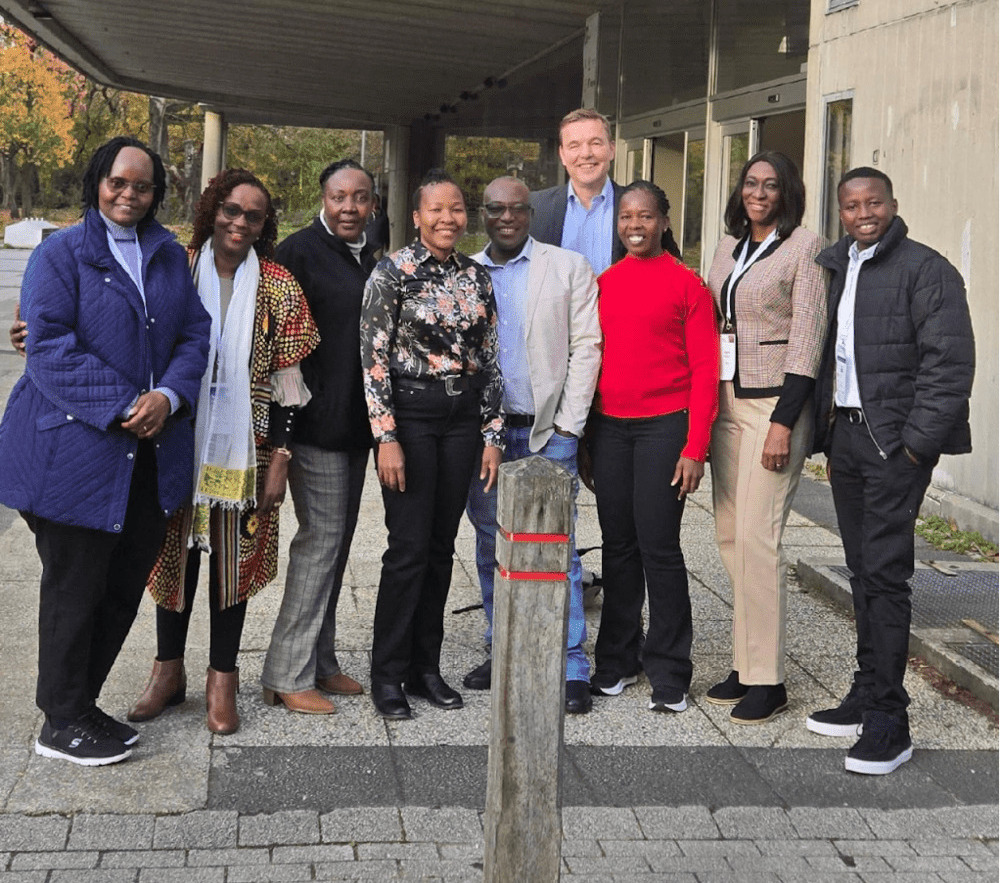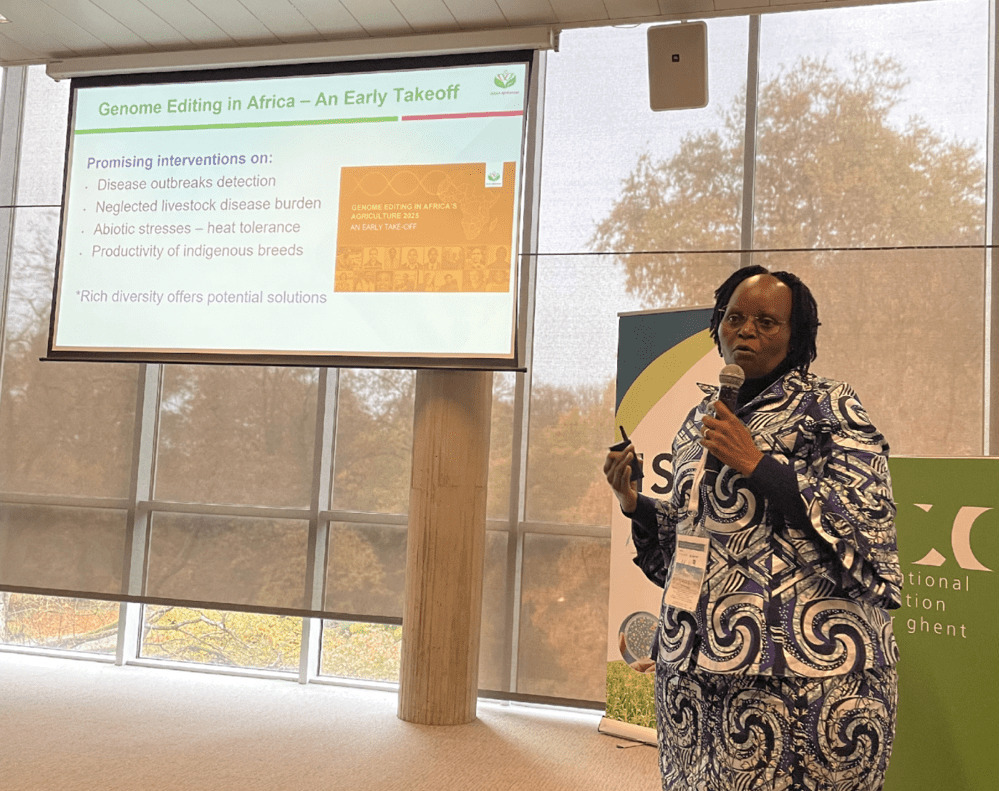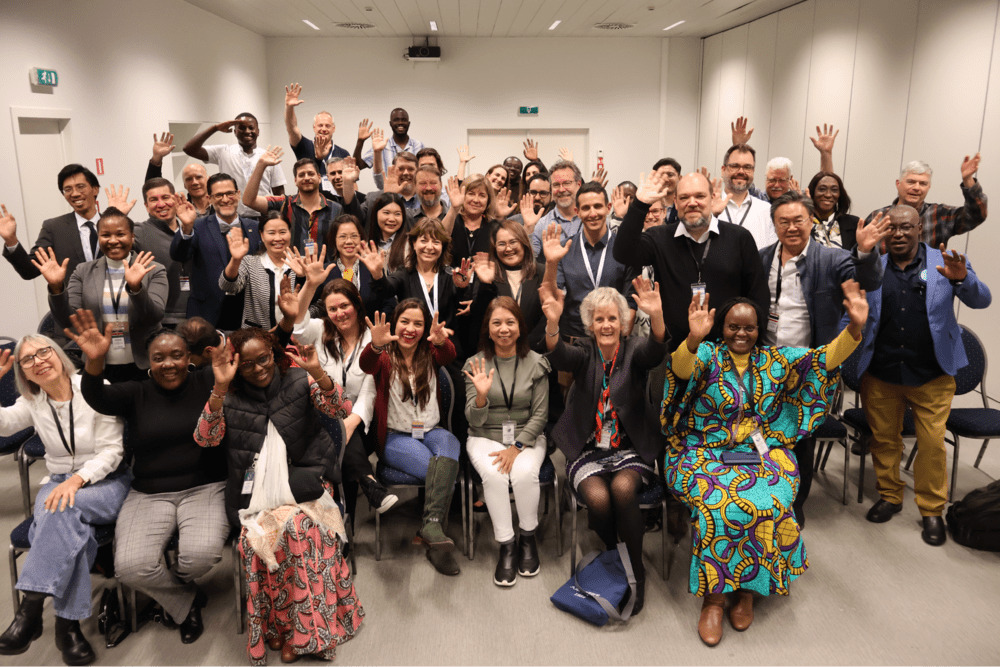Dr. Godfrey M. Ngure
Program Officer, ISAAA AfriCenter
By the time the lunch break ended on 6 November, 2025, Ghent’s International Convention Center already felt like a second home. I had spent the morning immersed in the final sessions of the 17th International Society for Biosafety Research (ISBR) symposium, yet as we transitioned into the afternoon, the atmosphere in the corridors began to shift. The same venue that had hosted days of plant and microbial biosafety discussions – with occasional sneak peeks into animal biotechnology – was now humming with a more focused anticipation: in-depth conversations on animals, genome editing, and the kind of regulation that can either unlock innovation or quietly smother it.
As an early-career professional from Africa, I walked into the Sixth International Workshop on Regulatory Approaches for Agricultural Applications of Animal Biotechnologies (IWRAAAAB) feeling both unseen and unusually small. This was not a generic scientific meeting. It was a focused gathering of regulators, developers, and policy thinkers from around the world, convened to ask hard questions about how to govern emerging animal biotechnologies in ways that are science-based, proportionate, and genuinely enabling. The agenda read like a live map of where the world currently stands: updates from the European Union, North America, Latin America, Asia and Oceania, and crucially for me, case studies and perspectives from Africa.
The turning point of the workshop, at least from my vantage point, came when Africa took the floor. In her talk on regulatory pathways for animal biotechnologies in Africa, the Director of the International Service for the Acquisition of Agri-biotech Applications (ISAAA) AfriCenter, Dr. Margaret Karembu, MBS, framed the continent’s livestock sector not as a problem to be solved, but as a rich, diverse system under pressure – and therefore ripe for smart innovation. Africa’s livestock keepers are grappling with recurrent disease outbreaks, heat stress, and the low productivity of indigenous breeds, yet those same indigenous genetic resources hold immense potential for climate resilience and disease resistance if the right tools are applied. Genome editing, she argued, is emerging as one such tool.
What struck me most was how far Africa has already moved – quietly, but decisively – on the regulatory front. Seven countries (Kenya, Ethiopia, Malawi, Zambia, Nigeria, Ghana, and Burkina Faso) have now adopted product-based approaches that distinguish genome-edited (GnEd) animals from classical genetically modified (GM) and exempt edits without novel traits from GM oversight, treating them as equivalent to conventionally bred animals. This is not just a technical nuance; it fundamentally changes the innovation calculus. For African researchers and developers, it means that if a genome edit does not introduce a new risk hypothesis, the regulatory pathway can be shorter, clearer, and more predictable. For regulators, it means limited resources can be concentrated on dossiers where genuinely novel risks may arise.
Layered onto this national progress is a continental vision: the AUDA-NEPAD Policy Framework for Applications of Genome Editing in African Agriculture. Rather than each country reinventing the wheel, the framework offers a strategic blueprint that AU Member States can adapt for their own policy and regulatory systems, with explicit attention to risk-proportionate oversight and investment alignment. From where I sat, surrounded by regulators from LATAM, North America, the EU, and Asia, it was clear that Africa is not merely catching up; it is positioning itself as a serious, coherent partner in the global conversation on animal biotechnology governance. The promise of regulatory harmonization across African countries – reducing duplication, smoothing approvals, and facilitating intra-regional trade in GnEd animal products – felt both ambitious and entirely necessary.
The workshop was not all plenary talks and policy diagrams. In the afternoon, we broke into case-study groups to stress-test our thinking against realistic scenarios. I joined the “Fish” group, where we examined myostatin knockout tilapia and sterile salmon null segregants, working through what a “novel pathway to harm” might look like and how a risk-proportionate regulatory approach should respond. Serving as a scribe for the group was an unexpectedly powerful learning experience: I had to listen carefully to how seasoned regulators framed uncertainty, what evidence they considered sufficient, and how they weighed environmental, animal health, and socio-economic considerations in a single conversation.
Throughout the discussions, one theme kept resurfacing: technology alone is not enough. Persistent misinformation and disinformation – often recycled from earlier debates on GM crops – continue to erode trust in any technology that carries the word “genetic” in its description. If genome-edited animals are to reach African farms in ways that are socially acceptable and ethically grounded, then stakeholder engagement and science communication cannot be afterthoughts. They must be built into the regulatory and innovation ecosystems from the start: from transparent communication of risk assessments, to co-creation of messages with farmers’ organisations, veterinary professionals, consumer groups, and faith-based leaders.
For me, as a young African scientist, the workshop also sharpened a more personal conviction: the youth constituency cannot remain on the sidelines of these conversations. Many of the livestock keepers who stand to benefit from heat-tolerant cattle or disease-resistant poultry are themselves young, navigating volatile job markets and climate uncertainty. Youth networks in biosciences and One Health are uniquely placed to bridge technical detail with relatable storytelling – to translate dense regulatory language into narratives about healthy herds, resilient livelihoods, and safe, accessible food. Spaces like the IWRAAAAB, where early career professionals sit alongside global regulators and industry leaders, are not just capacity-building opportunities; they are laboratories for shaping a new culture of dialogue around bioscience innovation. The 6th IWRAAAAB was co-organized by the University of California, Davis; ISAAA AfriCenter; the Inter-American Institute for Cooperation on Agriculture (IICA); and ISAAA Inc., with support from the United States Department of Agriculture – Foreign Agricultural Service (USDA–FAS).
As the workshop drew to a close, I felt a quiet sense of momentum. Africa is still at the early stages of deploying genome editing in animal agriculture, but the direction of travel is not in doubt: toward clear and risk-proportionate regulation, toward continental coherence in policy, and toward more intentional, evidence-based public engagement. For those of us at the beginning of our careers, this trajectory is both a responsibility and an invitation – to help ensure that the tools of modern biotechnology are deployed wisely, communicated honestly, and anchored in the everyday realities of African farmers and consumers.
***
About the Author
Dr. Godfrey M. Ngure is a Program Officer at ISAAA AfriCenter specializing in science diplomacy, strategic science communication, stakeholder engagement, and policy advocacy. He holds a Ph.D. in Biotechnology from the University of Tsukuba (Ibaraki, Japan). Dr. Ngure leads networks of early-career bioscience professionals and coordinates initiatives that advance science, technology, and innovation in support of national, regional, and global development priorities. He serves as the Secretariat to the Africa Youth for Biosciences Network (AYBN) and the African Association for Advancements in Synthetic Biology (AAASynBio). You can reach him via email at gmngure@isaaa.org or link up with him on LinkedIn.


